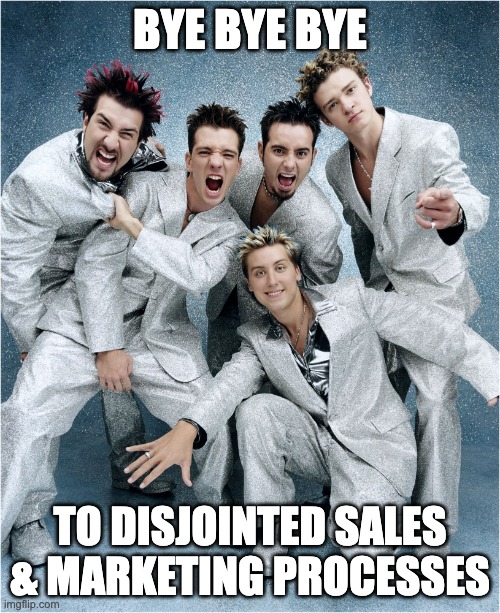What can I say about sales and marketing alignment? When I was a little-bitty editorial assistant at my first post-college job, I shared a cubicle wall with the organization’s top sales rep. Nice guy; he spent a lot of his time on the phone, naturally, and I pretty much tuned him out.
Except that sometimes the conversation on his end told me he wasn’t talking to a customer. “Are they asleep at the switch?” was one of the nicer things I heard.
(Spoiler alert: he was talking about marketing.)
Were they, in fact, asleep at the switch? Not at all.
They were working their butts off, something I personally confirmed when I later joined the department. We ran some really cool creative campaigns that occasionally generated above-average response. What they didn’t translate to enough was wins for sales.
With shifting conditions, marketing dives deeper into the sales funnel
Before I wander too far down memory lane, I’ll circle back to the point of this story: In the traditional sales-marketing structure, marketers attract and capture leads and hand them off to sales reps who then, in theory, convert them to happy customers. The end.
That’s the old story. (Hint: It didn’t always make for happy endings. See above re: dismayed sales rep on the other side of my cubicle wall.) Today, new plot twists, including a more complex buyer journey and a shift toward recurring revenue and revenue expansion, require constant collaboration on the part of sales and marketing teams. (Think ABM.)
B2B marketing now needs to lend expertise to the entire sales cycle rather than restricting activity to the top of the funnel. However, despite these new demands, a lot of B2B marketing departments are still geared toward the old way of doing things.
Why marketing and sales need to be like…a boy band?
This future of B2B marketing has sales and marketing departments working together in perfect harmony, with each side touching a prospect or customer at different points in a cohesive journey.
That means we need to get ‘N sync and move in One Direction together, working toward a couple of common goals: a customer-first mindset and generating revenue for the organization. (See what I did there?? Please don’t say Bye-Bye-Bye to me for that.)
Make sweet music versus off-key discord
Plenty of research shows that tight alignment between B2B marketing and sales departments produces benefits like reduced costs, more closed deals, higher revenue, better customer retention, increased ROI for marketing and increased productivity for sales. Then there’s the cute stuff, like everyone getting along better.
On the other hand, lack of alignment between sales and marketing results in a lot of hard work…and a lot of missed opportunities.
So sales + marketing = alignment = no brainer, amirite?
It’s getting there that’s the hard part. Even seasoned marketers may struggle to re-orient goals and activities to support the entire sales cycle. In fact, according to new research from Outfunnel, nearly half of surveyed marketing professionals report they don’t feel well-aligned with their sales departments.
But really, how do we close the gap?

Craft a buyer persona together, with each team contributing their key insight: marketing no doubt has input like customer surveys, focus group research, and social media feedback at their fingertips, while sales intimately knows the buyer pain points your offerings can solve.
Then, evaluate your tech stack to ensure it powers tight alignment. This is eas
ier said than done; integrating a tech stack well is an interactive process that may take you a couple of tries (or maybe fifteen) to get right. But it’s worth the effort. Next-generation martech tools enable sales and marketing teams to collaborate on goals, synchronize touches and truly orchestrate activities to meet the expectations and needs of today’s B2B buyer – and deliver wins for both teams.
Technology for true sales and marketing integration
I’ll take us back to the mid-aughts, and again, my old job. The sales team used this mysterious thing called a CRM. Marketing used list management software. Just as we humans didn’t talk to each other much, neither did our systems. (Marketing automation solutions were a glimmer in the eye.)
But the modern-day marketer is so lucky! We have a s&%* ton of martech tools to remove the complexity from our lives (more than 8,000, if you check out Scott Brinker’s Marketing Landscape infographic).
Now, let’s talk about how each one can improve sales and marketing alignment.
Just kidding.
The preeminent martech to help close the sales and marketing gap is a high-impact CRM platform and marketing automation. Used together, they can help sales and marketing teams transform good intentions of collaboration into reality.
Other tools in your stack can contribute to alignment as well, such as content management systems, ABM solutions and email and social media campaign tracking apps.
CRM and automation: Achieve collaboration and efficiency
Here’s a look at specific sales v. marketing challenges a well-deployed CRM with integrated automation tools can solve.
Lead hand-off strategy. Ineffective lead handoff makes for nasty bottlenecks in the sales pipeline. Automation tools integrated with the CRM can help solve some of the most common issues, like identifying sales-ready leads and the type of outreach that makes the most sense. With lead scoring capabilities, your teams can assign values to various attributes like source, engagements and behaviors, and the system will automatically rank leads. This helps ensure timely, on-point response to qualified leads and eliminates the manual effort of evaluating leads by hand.
Multi-channel orchestration. Remember, it’s no longer okay to hand a lead off to sales and move on. We need that back-and-forth approach. Timing outreach so that sales and marketing don’t bump into each other and piss off the customer is pretty crucial.
CRM platforms can track the history of customer engagement so that marketing and sales know exactly what type of outreach has been performed and at what stage. Marketing automation workflows can be set to support well-orchestrated timing, with customer behavior (e.g., form fill requesting access to a gated asset, request for a demo, opt-in for an e-newsletter) triggering an alert to the appropriate rep or marketer. This eliminates guesswork and ensures the customer is getting info that’s not too much, too little, too soon, or too late.
For example, in response to a landing page form-fill requesting more information, marketing might send an email reinforcing the product or service value prop. Sales receives an automatic notification to follow up with personal outreach. Then, depending on that outcome, it’s either back to marketing to conduct further nurturing, or maybe the sales rep keeps ownership but gets behind-the-scenes support from marketing in the form of customized content.
You’re getting the gist, right? It’s a game of back-and-forth, with both teams involved the whole way through. And the best way to do this in a way that makes sense for the customer is by tracking every touch in the CRM and setting automated workflows for messaging that fits together seamlessly.
Tying marketing efforts to sales revenue. Tracking the entire process in the CRM positions marketers to quantify the value of marketing activities in relation to how they’re directly contributing to sales revenue. For example, you can track metrics like marketing-qualified leads that become sales-accepted leads, and then revenue generated from those SALs that convert.
How industry leaders are elevating sales and marketing integration
Big-name players in the martech space are adding capabilities and functionality to support sales and marketing integration.
HubSpot, for example, has built its entire suite to include sales and marketing on the same platform. Salesforce acquired marketing automation solution Pardot to integrate marketing into its CRM software platform.
Other marketing-specific tech like automation solution Marketo and campaign management SaaS Oracle Eloqua are prebuilt to integrate with various leading CRM platforms.
There’s never gonna be a one-size-fits all when it comes to choosing the right martech to support sales and marketing alignment. Remember the basics: get together first and do the manual work with input from both departments. Then, together, evaluate and choose tech that supports agreed-upon goals and processes – never the other way around.
Here’s to duets over solos, staying ‘N sync and not veering off onto dead-end Backstreets…and I’ll stop now. Go get your alignment on, friends!











